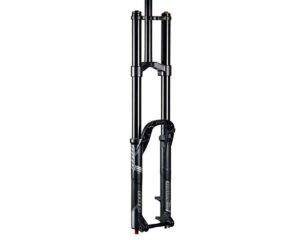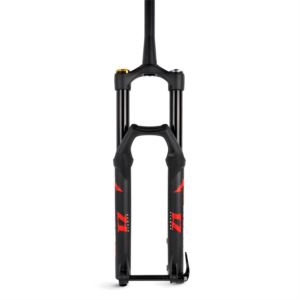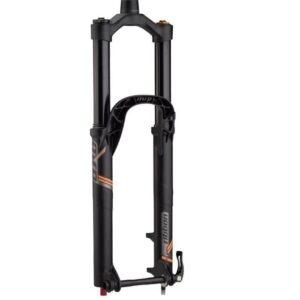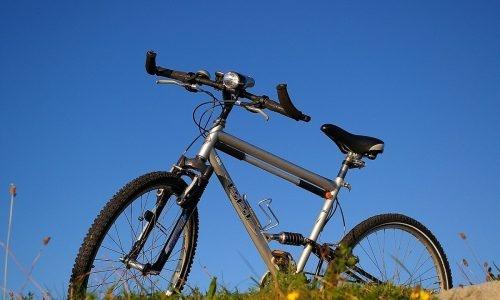When talking about mountain bike forks, there are two main groups that forks can fall into: single and double crown forks. Double crown forks attach both above and below the head tube, hence the name double crown.
Single crowns mount only below the headtube, meaning that they can be made far lighter, are more manoeuvrable but are less stiff. In general, double crown forks are limited to downhill bikes due to their weight and subsequent difficulty to manoeuvre and pedal. Single crown forks have a much wider application, across disciplines from cross-country to enduro with varying sizes for each purpose.
For this article, by ‘best’ I’ll look at travel, thickness of the stanchions and price of most major brands’ top-of-the-range forks.
Double Crown Fork
RockShox Fork BoXXer Ultimate Charger2.1 RC2 – 27.5″ Boost 20×110 200mm Red, 36 Offset DebonAir (ZipTie Fender, 2 Btm Tokens, Star nut & Maxle Stealth) C2

First up is the RockShox BoXXer, coming in at $1699. The BoXXer is RockShox’ largest and most rugged fork. It accommodates both 27.5 and 29 inch wheels and comes with 180, 190 or 200 millimetres of vertical travel.
The stanchions have a 35mm diameter, which isn’t as large as those on some competitors’ models. It has external adjustment for both high and low speed compression and uses a token system to manage ramp-up. It weighs just over two and a half kilos on the 27.5”, 200mm model.
The RockShox Maxima Plush fluid claims to silence annoying damper noise, and the new Charger 2.1 damper claims to “reduce hand fatigue and fight unwanted friction”.
MRP Bartlett Dual Crown Air Fork (Black) (27.5″) (15 x 110mm) (49mm Offset) (180mm)

Next is the MRP Bartlett fork, coming in at $1212.99. The Bartlett can accommodate a 27.5 or 29 inch wheel just like the BoXXer, but is only available at 170, 180 and 190 millimetre travel. Subsequently, it weighs ~100g less than the BoXXer, at just under two and a half kilos in the 27.5”, 190mm configuration.
The stanchions are 35mm however only low speed compression can be adjusted externally. Ramp up is controlled externally however, not with tokens that have to be added inside the fork.
The MRP Bartlett can accommodate a 180 millimetre brake rotor and comes with all of the parts required to reduce or increase the travel, as the fork is designed not only for downhill but instead using the “dual-crown design [to] provide space efficiency over a single-crown” which they claim allows for a longer travel despite having a shorter axle to crown length than a single crown fork.
Fox 40 Float Factory GRIP2 2021 Fork

Next is the FOX 40 Float fork. Fox’ largest fork comes in at nearly £1900, which is over $2600 dollars. The fork boasts 203mm of travel and 40mm stanchions. The fork also weighs around 2.8 kilograms, which is far heavier than the prior two forks.
High and low speed compression can be adjusted externally as well as both high and low speed rebound, which is a feature often grouped into one on other manufacturers’ forks.
The fox fork is far heavier than other brands, but is larger than other forks, whilst sporting the ability to fit a massive 230 millimetre brake rotor where others may fall shorter of that.
Emerald – DVO Suspension

Next is the DVO suspension Emerald inverted double crown fork. The DVO uses an uncommon approach by placing the station at the bottom of the fork, rather than having it at the top like other manufacturers. The fork boasts 203mm just like the FOX 40 but has 36mm stanchions, larger than the BoXXer but smaller than the Fox 40.
The DVO Emerald also has a unique tuning system, where the negative spring can be preloaded to provide ramp up separately from the air pressure in the fork. For example, a light rider can run low pressure but reduce the ‘OTT’ (off the top) adjustment to keep the fork from sagging or reduce it to have a more linear travel. The DVO is also listed as costing ~$1500 – $2250, however I have found it to cost £1040 ($1450)
Conclusion
Overall, there are two major competitors in double crown fork production: RockShox with the BoXXer and Fox with the 40 Float. Both are top of the range, high performance forks, with the Fox 40 taking home the first UCI world cup women’s race with Camille Balanche at Leogang this year, and the BoXXer taking home the men’s race with Troy Brosnan. Overall, I would personally be inclined to buy the RockShox BoXXer due to its weight savings and cost savings, being almost $1000 less than the Fox 40 whilst evidently still being a very competitive fork.
Single Crown Fork
Fox Racing 38 Float Performance Elite Fork – 27.5

The First fork is the Fox 38 float, with its main draw being its massive 38mm stanchions, much larger than most double crown downhill forks. These wide stanchions give it a very stiff feel and give it a beefy look.
The 170mm travel makes it perfect for rough trails whilst not being cumbersome like a longer alternative or a double crown fork. It weighs just under 2200 grams and can accommodate huge 3 inch tyres and 230mm rotors.
The fox 38 has a lot of external adjustment, with high and low speed compression and high and low speed rebound too. This gives the rider greater control over the fork to give the perfect feel.
The fork is very smooth, aided by the floating axles and that aforementioned stiffness holding the fork straight through its travel. The fork is available on evo.com for $1,149, the most expensive fork on the site.
RockShox ZEB Ultimate Charger 2.1 RC2 Fork – 27.5″

The second fork is the Fox 38s direct competitor, released in response to Fox’s new fork: the RockShox ZEB ultimate. The fork is available from 160 – 190mm in 10mm increments. The forks also have an e-bike specific model called just the ZEB.
It uses 38mm stanchions just like the Fox, giving it amazing stiffness. It is over 20% stiffer than their other flagship fork, the Lyrik. It has additional negative air volume, which makes it resemble a downhill fork in it’s feel. It comes in both 27.5 and 29 inch sizes and is available for $999, $150 less than Fox’s counterpart.
You can adjust high and low speed compression, however rebound is concentrated to one adjustment. The fork accepts tokens to adjust ramp up (when the fork stiffens throughout its travel.) The fork weighs almost 2300 grams, so 100g more than the fox 38. It can accept 3.2” tyres, and a year more warranty than the Fox 38.
Marzocchi Bomber Z1 Coil Fork – 27.5″

Next up is the Marzocchi Bomber Z1 Coil fork. The Marzocchi Bomber shares some of the main chassis with the fox 36, so has stanchions 2mm thinner than the 38 and the ZEB. It boasts a Fox Grip damper but with is coil sprung instead.
If you want a coil spring, this is one of the highest end options. The coil system is suited best for high travel forks as it provides a perfectly smooth travel throughout it’s entire travel. The disadvantage of a coil fork is that the spring must be replaced to truly tune it to the rider’s weight unlike an air fork that you can just pump up or reduce the pressure in.
Using internal spacers, the fork travel can be changed by the rider. As far as external adjustment, you can adjust preload, rebound and it has air assist to control ramp up and to help the fork to stop bottoming out.
The fork is very heavy compared to the other two so far, coming in at over two and a half kilos actually weighing more than the MRP Bartlett, a double crown fork. Coil forks do tend to weigh more, but for those who like the specific feel, the Marzocchi is arguably the highest end option. Coil forks in general are cheaper due to their simplicity and the Marzocchi is no exception, coming in at $779.99 on Evo.com
MRP Ribbon Suspension Fork 27.5 160mm 110×15

The MRP Ribbon is a 160mm fork, with its main selling point being its incredible adjustability. MRP actually developed their ramp up control cartridge back in 2017, and the Ribbon has this same control.
The Ribbon also has both positive and negative air chambers, giving great control over the fork’s performance. It has a pressure relief valve, which keeps the fork performing the same at high altitude and when being ridden especially aggressively.
The fork can only accept 2.3 inch tyres, which is smaller than the other forks, with 27.5” wheel size where the others could accommodate 29” too. The MRP Ribbon also uses their distinctive arch design which may at first look back-to-front, but actually is designed that way so as not to collect mud off the front wheel which can collect making annoying noises whilst adding unnecessary weight to the fork.
Conclusion
In the single crown category, I would personally prefer the RockShox ZEB as it has the advantages of a long travel, 38mm stanchion single crown fork, but for $150 less than Fox’ alternative fork.
Although I think that Fox or Marzocchi have better styling than RockShox and will turn more heads, the value for money on the RockShox ZEB is undeniably better than the Fox 38. It also has more travel by 10mm and at 190mm in a single crown configuration, it definitely is unique.
Overall, if we’re talking in pure downhill performance, I think that the disparity in performance between the FOX 40 and the RockShox BoXXer is so minute that either could be considered the ultimate in downhill racing, but for the average consumer, I think that the BoXXer is just more appealing from the view that it costs almost $1000 less than the Fox 40. Both have been shown to be able to perform incredibly, both taking wins regularly at the world cup downhill.
As far as overall performance, with climbing and downhill in mind, again the Fox 40 and RockShox ZEB are too close to call. The prices are broadly comparable, with the ZEB being cheaper, separated by only a 15% price difference and the ZEB also being slightly longer but at the cost a 5% difference in weight (with the Fox 40 being lighter).

Tim Hunt is an amateur mountain biker from the Surrey Hills area of England. He has been riding and building for many years in and around the Surrey Hills and loves fast and techy descents!


